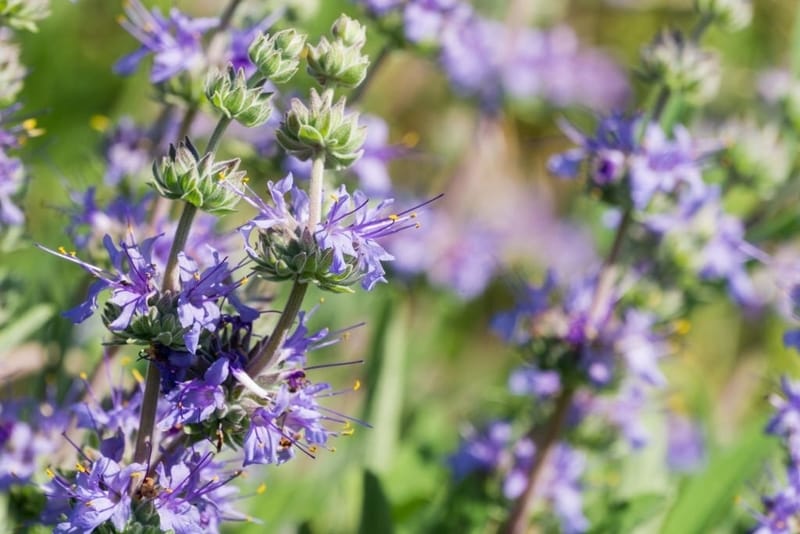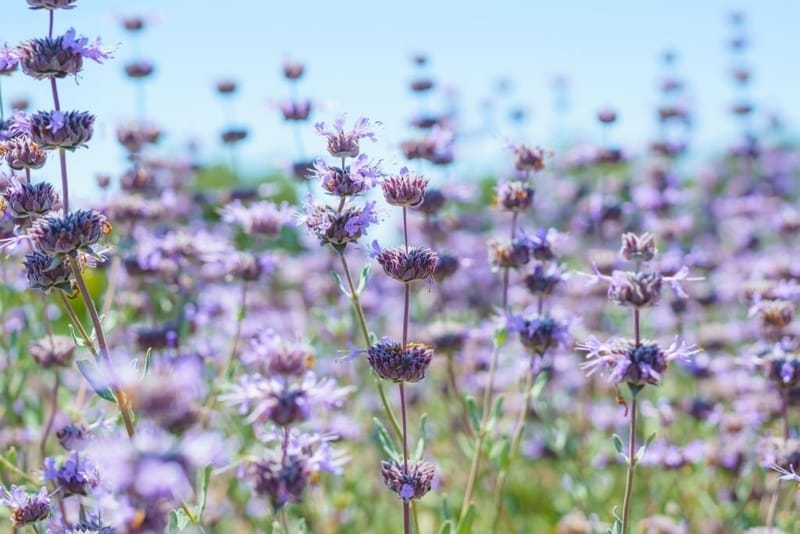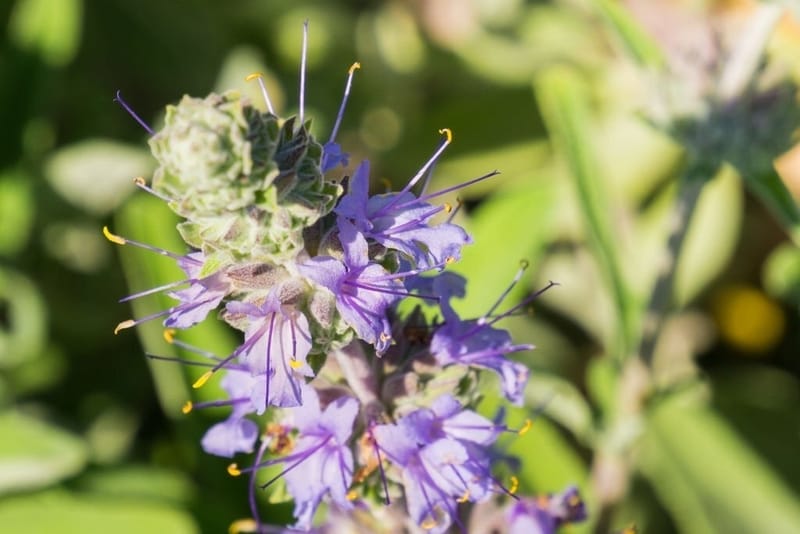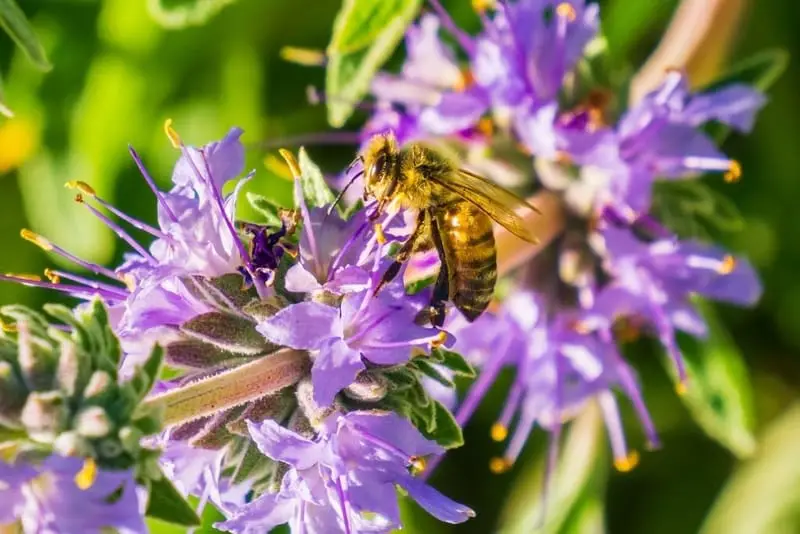Salvia Clevelandii is a perennial shrub with blue flowers that is native to California.
Salvia Clevelandii belongs to the Lamiaceae family. This means that it is related to mint, basil and other fragrant herbs. The Salvia Clevelandii has many common names including Cleveland sage, Blue Sage, Fragrant Sage.
Salvia clevelandii make excellent plants for native plant and wildlife gardens, attracting many pollinators, especially hummingbirds. The flowers are small but they are borne in abundance on the tips of stalks.
It has lavender-blue flowers that bloom from May to August and grow in spikes. The plant grows best in full sun and can reach up to four feet tall by four feet wide in its first year, with additional growth after that point. It has grayish green leaves and will thrive in any area where it receives at least six hours of sunlight per day.
About Salvia Clevelandii
Height and Width
The Salvia Clevelandii is a shrub with a height of about 4 to 6 feet and has a spread of about 4 to 6 feet, which makes it an excellent choice for people looking for a groundcover in their garden or on the edge of their property.
Sun
The ideal exposure for Salvia clevelandii is full sun, with partial shade being the next best option. Full-shade exposure can be tolerated, but it’s not recommended because it will make your plant more susceptible to disease and insect infestations. Shady areas do not give your plant enough light to thrive or bloom.
You want to ensure that each leafy branch gets at least six hours of direct sunlight during the day so that its growth stays strong and healthy. If you are growing it indoors under artificial lighting, then you should aim for 14–16 hours of illumination per day.
Pruning Salvia Clevelandii
When pruning your Salvia Clevelandii, you should start by removing any faded flowers from the plant. You can also remove dead leaves and stems from the plant if they appear brown or black in color.
The next step is to trim away any branches that are growing too close together or look like they may be crowding other branches out of space. If you notice any crossing branches, you should cut them back as far as possible without damaging other branches on the plant.
Once these steps have been completed, you will need to wait until late spring before doing any further pruning on your plants so they have time to recover from their first season outdoors without being stressed by frequent changes in climate conditions.
Water
If you are a gardener and you have a Salvia Clevelandii plant, then you should know that it does not need much watering. This evergreen shrub is a drought-tolerant and can survive with very little water.
Soil
This plant requires well-drained soil with good moisture retention, especially during the summer months when it’s actively growing.
To make sure your Salvia Clevelandii grows up healthy and strong, make sure you choose a location with good drainage and plenty of sun.
If you’re planting in your backyard, try to find a slope that will allow water to drain away easily. If you don’t have any natural slopes on your property, consider building one where your plant will grow.
Uses
The Salvia Clevelandii plant is great for borders because it provides height and color to any garden bed, it can also stand up to foot traffic and other pests that might damage more delicate plants.
It can also be used as a focal point in your garden by planting it near another plant that is shorter or smaller in size. The plant will grow up to reach anywhere from 4-6 feet tall and 3-6 feet wide when planted in the ground.
The leaves on this plant are gray green, which makes them look very decorative when paired with other plants that have contrasting colors such as reds or yellows.
It’s also great for containers or mixed borders because it blooms all summer long and provides food for pollinating insects like bees and butterflies.
Disease and pests
Root rot
The Salvia Clevelandii is prone to root rot if it is planted in an area with too much moisture or waterlogged soil. It should be planted where there is good drainage so that water does not pool near the roots of the plant.
The Salvia Clevelandii will grow well in sandy soils or loam soils if they have been amended with composted materials such as leaves or bark chips before planting time. If you live in an area where there is heavy clay soil, it may be necessary to add more sand or compost material before planting so that your plants will have enough room for their roots without compacting them down too tightly together during growth cycles later on down the road.
Nematodes
Nematodes are tiny worms that can cause serious damage to plants by burrowing into the roots and disrupting their ability to absorb nutrients from the soil. Nematodes are especially harmful during hot summer months when plants are most vulnerable.
To protect your plants from nematodes, keep them watered regularly throughout the hot summer months, but do not over-water them so much that you create an environment conducive for these worms to thrive in. Another way you can prevent nematodes from destroying your plants is by using mulch around them instead of soil; this will help keep moisture levels high without creating spaces where these worms can thrive.
Spittlebugs
Spittlebugs are a common pest of many plants, including the salvia clevelandii. They are sap-sucking insects that feed on the juices of plants. They are small, usually less than a centimeter long, and have soft bodies and long antennae. Spittlebugs excrete excess water as frothy droplets of “spittle” or “froth,” which is why they are also called froghopper or spittlebug.
The most common spittlebug species found on salvia clevelandii is Brown Spittlebug. Its color ranges from yellowish-brown to reddish-brown with dark spots and stripes. It can be identified by its ability to jump high into the air when disturbed.
This insect lays eggs in clusters on the stems of plants, these eggs hatch into nymphs, who then molt several times before becoming adults. Adult spittlebugs feed on the underside of leaves and use their mouthparts to pierce plant tissue and suck out its contents, this causes damage to both leaves and flowers, resulting in wilting or curling up of leaves during late summer months.
The best way to control spittlebug is to prevent it from getting on your plant in the first place. To do this, you should use a soap-based spray on your plant that will kill any insects that land on it. You can also try using sticky traps around your house and garden to catch any insects that might try to get inside your home or yard.
Do Deer eats Salvia Clevelandii?
Deer do not eat Salvia Clevelandii. This is because the fragrance of these plants is very strong and it does not taste good for them. They usually try to stay away from this plant and avoid it.
Read my previous article on: What is eating my Salvias & How Keep Them Away From Your Plants
 FAQS
FAQS
Q: Is Salvia Clevelandii poisonous?
A: Salvia Clevelandii is not poisonous.
Q: Where can I find Salvia Clevelandii?
A: You can find Salvia Clevelandii in fields and forests across North America and Europe, as well as in Australia and New Zealand. It tends to grow in areas where it doesn’t get too hot or cold during the year, but it can also be found growing on rocky slopes or hillsides.
Q: Is Salvia Clevelandii plant a good plant to have in my garden/home?
A: Yes! It’s a great choice for any garden and will bring a touch of class and sophistication to any space.
Conclusion
There you have it! The Salvia Clevelandii is a great addition to your garden, as it attracts bees, butterflies and hummingbirds. This plant will be sure to add some color and beauty to your yard! You can enjoy this plant as a shrub or as a groundcover.
If you want to attract butterflies to your garden, then this is the perfect choice for you! It’s easy to grow and care for and will provide lots of color throughout the spring and summer months of each year.
Thanks for reading!
Also Read: Salvia Amistad | Everything You Need To Know About

 FAQS
FAQS